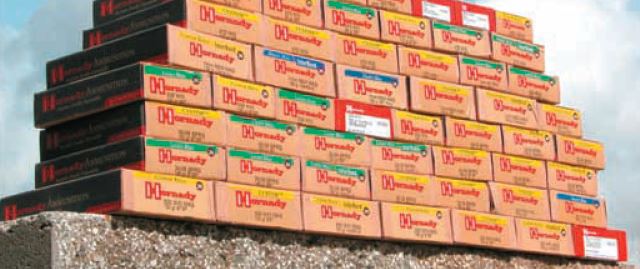
Just how good can factory ammo really shoot? The author gathered up some good rifles in nine cartridges and 53 boxes of Hornady Custom RifleAmmunition.
Being a passionate reloader for over 30 years, I was firmly convinced that handloads were the only way to go to achieve the accuracy levels I desired from my rifles. In fact, I am currently working on a big project that will prove to be very interesting. In it, a topic will be addressed that is pivotal to the future success of hunting and shooting. That story will come, though at a latter time. But if not for it, this story would not have come to be.
I had already assembled Steyr Mannlicher rifles in 270 Winchester, 7mm-08 Remington, 280 Remington, 7mm Remington Magnum, 308 Winchester, 30-06, and 300 Winchester Magnum. Thinking that I might not ever again have so many rifles of the same make on hand at one time, it would be a great opportunity to give some factory ammunition a real test to see how it performs. Also added were the 223 Remington and 243 Winchester cartridges.
A quick call to Hornady was in order. Were they up to the challenge? I suggested that he send me one box each of every loading they had on hand in all of the above cartridges. A week later, I had my answer; two very heavy boxes greeted me on my doorstep one day when I came home. Opening them, I found 53 different boxes of various Hornady Custom Rifle Ammunitions. What had I gotten myself into?!?!
The challenge had been answered. Now it was up to me to start shooting. But first, a lot of thought had to go into making this an accurate and fair test. How and where should I begin?
Chapter 1: The Shooting Foundation
Click for LOAD DATA CHART
Since these are only hunting guns, and it’s a fact that animals hardly ever give you a chance to shoot at them more than three times, the decision was made to shoot five, 3-shot groups with each ammunition type. This would allow for a few fouling shoots,
getting on target, and also for the re-shoot of any “called” flyers. Though I am a fairly good shot, I knew that over the course of shooting 265 groups, there was a chance I might make a mistake. After a while, I became very good at calling shots that had strayed due to my error. After...
those shots were carefully noted and marked, I would continue and fire one more shot into the group. Not wanting to have almost 300 separate, loose targets, I had custom targets printed up on fairly heavy tag board with 5 separate aiming points.
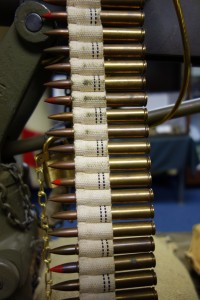
All testing was performed at the local outdoor range from a sturdy concrete shooting bench. Speeds were checked using an Oehler 35P chronograph, with velocities corrected to the muzzle. The chart listed speed for each load is the result of averaging the five group’s velocities.
I would begin with a thorough cleaning using Barnes CR-10 bore solvent on wire brushes. Dry patches would follow until they emerged from the muzzle as clean as they went in. On a separate spotter target, I would fire one or two shots to foul the bore, and verify for a reasonable striking point. After scope adjustments were made (if any), three cartridges were loaded into the magazine and then fired in a fairly quick manner. Shooting always began at the top left target aiming point and finished at the lower right.
The shooting started in the cool, early fall, with temperatures in the 50’s. As the months progressed, at times it was just above or below freezing. The velocities therefore should be representative of typical fall hunting temperatures. Virtually all loads were
shot while the wind was blowing (light to moderate), sometimes even while it was raining or snowing lightly. No attempts were made to always have “perfect” range conditions as these were hunting guns, shooting hunting ammunition. As such, I truly believe they very well represent what a good shooter could expect; assuming equally accurate rifles were used.
Note that I always shot four rifles, one after another, in sequence each time. I found that by shooting in rotation like this, by the time I was ready to shoot the first rifle again, it had fully cooled to ambient air temperatures. So my routine was fire 3-shots for group, change rifles, fire 3-shots for group, and change rifles, repeat… Thus, just as in hunting, each group was fired through a cold barrel. With fouling shots, and some called flyer “re-shoots”, this meant that the last group was going...
down a barrel that had already seen fourteen or more shots through it. When I finished shooting the four guns, each for five 3-shot groups, I would repeat the cleaning process, then grab the next box of ammo for each rifle, and start all over again.
When I called up Pat Mundy of Leupold to advise him of my intentions, he was quite happy to comply with my request for a half-dozen new scopes
I began by placing four of my five-aiming point targets up at 100 yards, numbering them 1 through 4. I used the .223, .243, 270, and 7mm-08 rifles to start. Ammo was shot lightest weight within each caliber to heaviest. So for my first round, I shot the 40-gr in the .223, 75 in the .243, 130 in the .270, and the 139 for the 7mm-08. On each box of ammo, with a black marker I wrote numbers 1, 2, 3 and 4 to correspond with the preceding sequence. Halfway through my shooting, I had a stack of targets with only the identifying one or two digit box number that corresponded to the ammo used. Nothing else was written on the targets to identify caliber or load. This was done on purpose to avoid prejudice when sitting down to measure all targets at once, but not until the test was completely finished.
Chapter 2: Rifles and Scopes
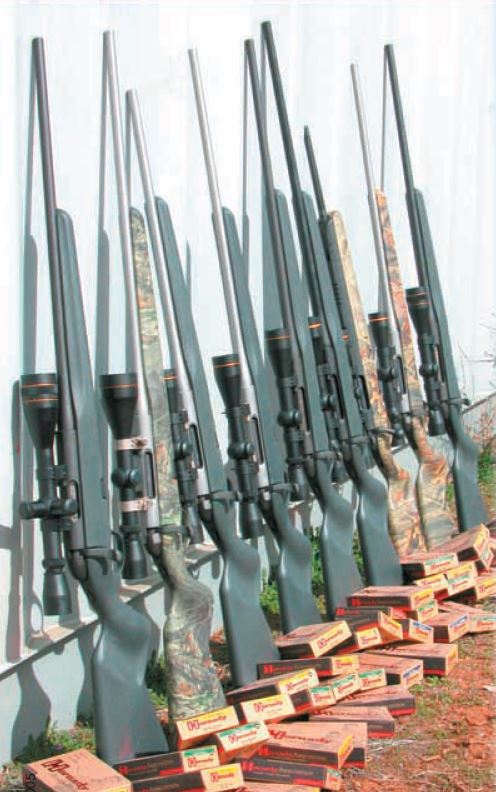
All of the rifles I used were synthetic stocked Steyr ProHunters, with the exception of the .308; it was a Scout model. I used my own personal .223, but borrowed from three friends a .243, .280, and .300 Winchester. Steyr USA loaned me rifles in .270, 7mm-08, 7mm Remington Magnum, 308, and 30-06 to complete the battery. Note that back when this test was performed, while Steyr shot every rifle for accuracy at the Austrian factory, US rifles were not shipped with a factory target. As such, the rifles they sent me from the US were not selectively hand-picked from inventory. They just grabbed each one from the top the stack.
The 243, 7mm-08, and 30-06 were stainless models. The 7mm Rem Mag was from a special run of stainless guns that had been black plasma vapor coated, giving the hunter a dark, non-reflective finish on a good...
foul-weather rifle. The 243 and 7mm-08 wore 20” barrels, the magnums run 25.6”, and the other standard chamberings were fitted with 23.6” barrels. Only the 308 Scout came with the still shorter 19” barrel length.
When I called Pat Mundy of Leupold to advise him of my intentions, he was quite happy to comply with my request for a half-dozen new scopes (and a nice new 12-40x60mm Golden Ring spotting scope- I wanted it to be easy to see my groups). All rifles, except the Scout, used Leupold QRW 2-piece bases. All used medium height QRW rings. The Scout used low rings. I have long received excellent service from this mounting system; this time was no exception. Scopes were selected to be fairly representative of what a hunter might install and appropriate for the gun/caliber size. The largest and smallest calibers both wore the Leupold 6-18x40mm VX- II scope with fine duplex reticles. All the rest had scopes ranging from a 2-7x33mm VX-I, up to a 3.5-10x40mm Boone and Crocket VX-III model.
Chapter 3: Results- Amazing Results
As a current owner of several Steyrs, I knew from experience that they are very accurate using my handloads. To date, not one of the rifles I have worked with has failed to shoot well under one-inch with my handloads, with some considerably better than that. I really have hardly used any factory ammunition in them up until now. That was about to quickly change. Using the above shooting procedure, off I headed to the range, again, and again, and again…
To date, not one of the rifles I have worked with has not shot well under one-inch with my handloads
Chapter 4: 223 Remington
While my personal ProHunter in .223 Remington is of the sporter barrel configuration (muzzle diameter of only 0.570”), early shooting with some old handloads I had on hand were very encouraging. A total of seven different Hornady loads were shot from this rifle. The bullets ranged in weight from an explosive varmint V-Max of only 40-grs, up to the heaviest being a 75-gr HP Match loading. In-between weights included 53, 55, 60, and 62-grains. Note that the TAP (Tactical Application Police) loads had cannelured bullets and a factory roll crimp. This really did not seem to matter to the rifle, as the loads ran from 0.69” down to 0.46” for five, 3-shot groups with each type. The combined average for...
the thirty-five groups fired came to an amazing 0.56”!
This rifle has become my favorite “walking” varmint rifle. It shoots better groups with its light sporter barrel than most shooters regularly get with a heavy-barreled version weighing several pounds more. Note that four of the nine loads had individual “best groups” ranging from 0.236 ~ 0.337”. This rifle is slated for further testing with handloads for sure. The Leupold 6-18x40mm VX-II Target scope made seeing bullet holes at 100 yards an easy task.
Forget your worries- my friend’s Mountain version averaged 0.66” over twenty groups, using the four ammunition types that Hornady offers
Chapter 5: 243 Winchester
If ever there were doubts about a short, light barrel shooting well, forget them. My friend’s Mountain version averaged 0.66” over twenty groups, using the four ammunition types that Hornady offers. The 75-gr HP’s shot into 0.62” or less, as did the racy looking 95-grain SST bullet, a choice load for deer or antelope. The other two loads, one using the same SST in a Light Magnum version, and a 100-grain BTSP, also can deliver the goods for the hunter, either shooting 0.70” or less. For smaller big game, either of the two 95-grain loads or the 100-grain SP would get the job done. I would try all three in your rifle to see which one it prefers. There was only about a 0.09” difference in accuracy between all four loads. This is the smallest differential recorded within any cartridge during the test. The 3-9x50mm VX-II scope proved a good match for the handy rifle- not too big, but not too small.
Chapter 6: 270 Winchester
Hornady sent me six loads to test in the 270 Winchester cartridge- two are conventional SP versions, two are plastic tipped SSTs, one is a BTSP loading, and the last uses the new InterBond bullet with the core fused to the jacket for improved weight retention and penetration, and a sexy red tip like the SST. The last bullet is loaded in a Light Magnum version, providing almost 3,200 ft lb of energy. With superior bullet performance, it would be great for “out yonder” shots on medium sized game. Its accuracy of 1.10” was bettered by only one other load, the 140-grain SST at 0.84”, and nearly matched by a 130-grain SP load, and a 140-grain BTSP. If you are seeking out medium game, any of these...
would certainly do the job. The average for the six tested loads came to 1.22” for 30 groups. Checking several in your rifle would let you know which ones it prefers. A classic rifle deserves a classic scope, a Leupold VX-I, 3-9x40mm.
Chapter 7: 7mm-08 Remington
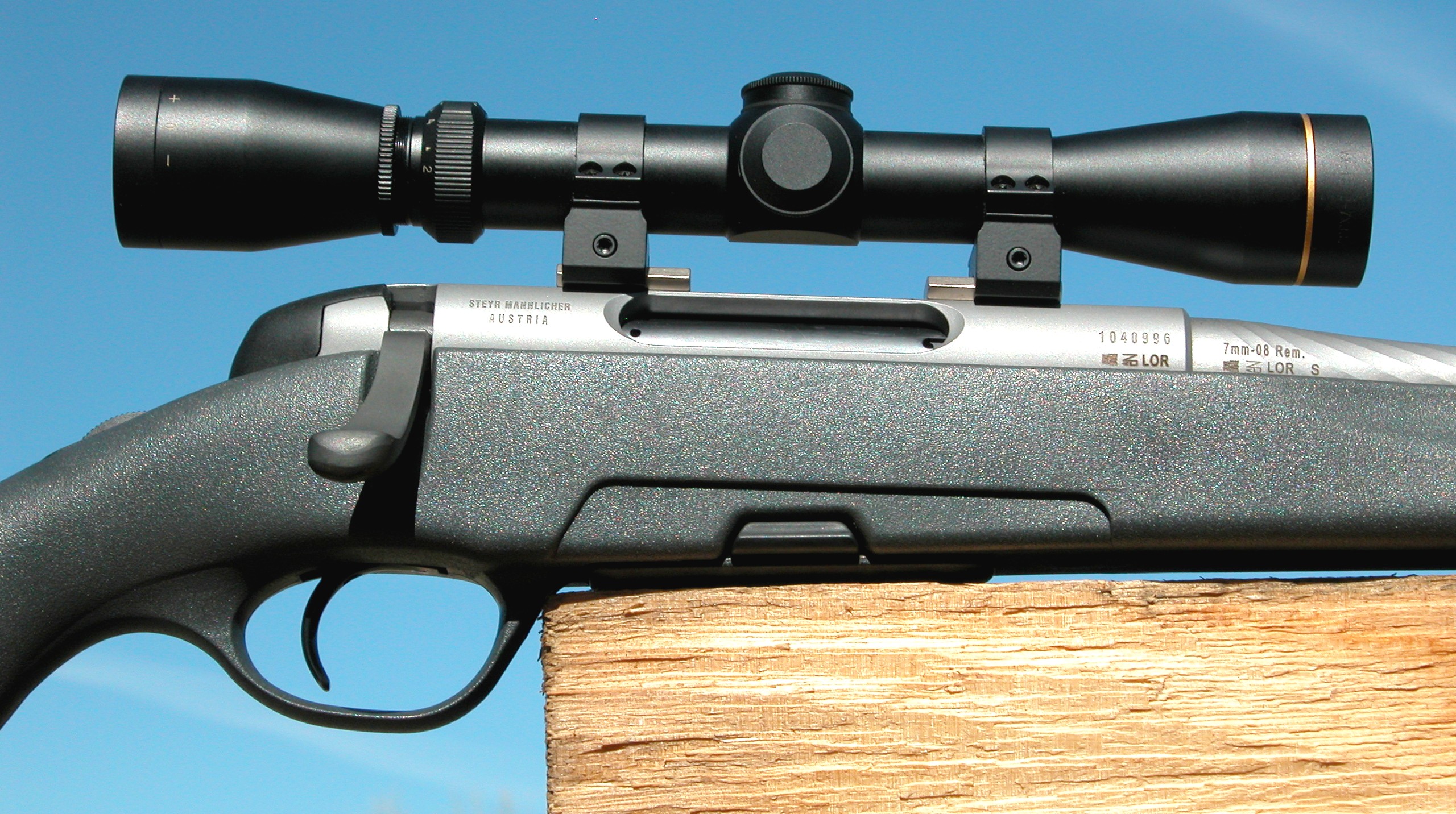
A long-time favorite cartridge of mine, I have used the 7mm-08 in a short compact rifle to take deer and antelope in Montana. Several friends of mine also regularly do the same. Though Hornady only makes one load in this caliber, it is a good one and fairly fast from the Steyr Mountain length barrel. It shoots into 1.03” at a speed of 2,792 fps. Note that this places it within about 150 fps of most factory 130-grain loads in the longer (cartridge and action) 270 Winchester, but it carries a heavier bullet with a higher ballistic coefficient. According to ballistic charts, between approximately 200 and 300 yards, it duplicates the drop and energy figures of the originally faster standard 270, 130-grain SP bullet. How would you like similar field performance from a shorter barrel and action on a lighter, easier carrying rifle? That is why I chose to put the compact-sized Leupold VX-I, 2-7x33mm scope on this rifle. It looks great and works even better.
Though Hornady only makes one load in this caliber, it is a good one, and fairly fast from the Steyr Mountain length barrel
According to ballistic charts, between around 200 and 300 yards, it duplicates the drop and energy figures of the originally faster standard 270, 130-grain SP bullet. How would you like similar field performance from a shorter barrel and action… on a lighter, easier carrying rifle? That is why I chose to put the compact-sized Leupold VX-I, 2-7x33mm scope on this rifle. It looks great and works even better.
...
Chapter 8: 280 Remington
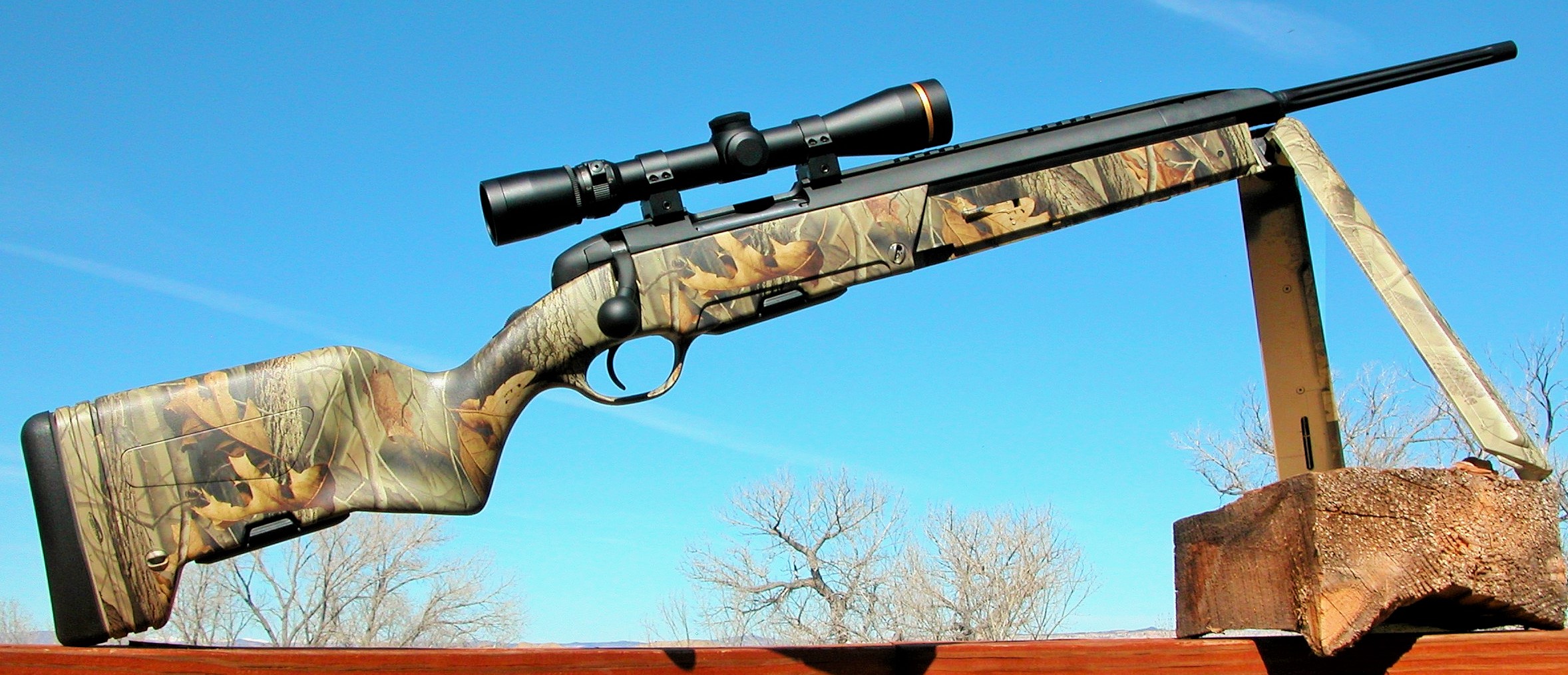
Never sell a rifle to a friend, unless you have shot it first! I sold this new rifle to my friend, who is a beginning shooter and hunter. Though I had never shot it, I knew it would be an excellent first rifle for him, good for medium to larger game. What I did not know though, was how well it would shoot!
Again Hornady makes but one load for the 280 Remington, but it proved to be a real doozy for sure. It is loaded with the 139-gr SST moly coated bullet in a Light Magnum version. With this load, from HIS rifle, I was rewarded with a 5 group, 15 shot average of only 0.60”! The speed of 3,044 fps places it so close to the heels of most factory 7mm Remington Magnums that game or hunter would not notice a difference in the field. Again, a classic scope, the Leupold VX-II, 3-9x40mm, helped me to guide those pointy SSTs in with ease. Note that the best 3-shot group with this fine rifle measured only 0.240”. With performance like this, I wish it was a boomerang so it would come back to me! I really, really enjoyed shooting this rifle with the Hornady Light Magnum ammunition. If ever there was a match made in heaven, this rifle with this ammunition is it.
Chapter9: 7mm Remington
I spent a fair bit of time several years ago in Montana, doing long-range hunting with the 7mm Remington Magnum. Fine for deer, antelope or caribou at medium to long ranges, it is also strong medicine against elk or red stag, as well as most African plains game. A very trim VX-III, 3.5-10x40mm Leupold scope with the new Boone and Crockett reticle (allowing for holdover estimation at longer ranges) looked right at home on this longer barreled ProHunter. The 25.6” barrel wrings out the last bit of speed from the powder charge for sure.
Fine for deer, antelope or caribou at medium to long ranges, it is also strong medicine against elk or red stag
The fastest load was a Heavy Magnum version, pushing a 139-grain SST moly bullet out at 3,315 fps, while keeping five, 3-shot groups into...
0.89”. A slightly slower load uses the same bullet, but in the InterBond format, averaging 0.71”. I can hardly imagine a finer long-range plains or mountain combination. The other three loads did as well, or even better, in the accuracy department. None grouped over 0.94”, with some averaging as small as 0.68”. The best single group came from the overall most accurate load as well, the 154-gr SP. Three-shots went into less than 0.344”. As soon as I get paid at the end of the month, off will go a check to Steyr. I am keeping this rifle for sure. I believe that Hornady will need to ship me a lot more ammunition for this gun so I can do a more in-depth evaluation. Why reload with high-level performance available over-the-counter like this?
Chapter 9: 308 Winchester
Though I have shot the 308 Winchester cartridge for decades, I did not hunt with it until 2001. Back then, I had the chance to make an eight-day safari in Zimbabwe for plains game. I took along a Steyr Scout in 308 because I really like the looks and feel of the Scout rifle. What I soon discovered in the field would win me over on the 308 and the 150-grain SST bullet.
Over a dozen head were taken with the Scout, mostly using the 150-grain SST. My most memorable shot was taken offhand at a departing zebra that had been wounded the previous day with another bullet. As the mare slowly walked away, I placed the bullet just behind the shoulder. It broke a rib going in, crashed through the spine, and exited off across the savanna. The zebra dropped in place at the shot; my professional hunter paced it off at 264 long paces (his, not mine). I was sold on the Scout, the 308 cartridge, and the Hornady 150 SST. For sentimental reasons, I asked Steyr to provide a Scout for testing the five loads Hornady had sent me, again mounting a VX-III, 2.5-8x36mm Leupold like I had previously used in Africa. On low QRW rings, it fits me and the rifle like a glove
What I soon discovered in the field would win me over on the 308 and the 150-grain SST bullet.
The 168-grain A-Max Match load averaged 0.75” in the light, fluted barrel of the Scout. It is impressive that both of the Light Magnum offerings, one in 150-grains and the other in 165, recorded velocities from the short barrel which duplicate most standard loads of the same bullet weight, in a traditional length 30-06 rifle. It was...
satisfying to see that the Scout averaged 1.02” with all five loads combined. I have never had warmer memories of a rifle and bullet combination in the field than I have of a Scout and the SST. I am happy to report that my Zimbabwean PH hounded me into selling
him my Scout after watching what it could do. It now lives a life in Africa of which most hunters could only dream.
Chapter 10: 30-06
Fifteen loads by Hornady were sent to me for this classic cartridge. It seems appropriate that the two best shooting loads were the old stand-bys- the 150 and 180-grain soft points. The first load averaged 0.77”, the latter an even 0.87”. Five other loads shot into 1.18” or less. Three of these were Light Magnum loads that approached traditional factory velocities for the .300 H&H. Without changing guns, a hunter would be well served tackling larger game with the 165-grain InterBond load, traveling 2,937 fps. The 150-grain SST Light Magnum shoots plenty flat for mountain hunting, delivering 3,053 fps from the 23.6” Steyr barrel. With only 0.67” difference in the 30-06 between the tightest shooting round and the least accurate (still shooting 1.44”), a hunter could select from one of these 15 loads and be well covered for most any type of hunting on most continents. I find it commendable that within such a broad range of loads, accuracy is satisfyingly good across the board. For a hunting rifle that might be carried a lot and used in a variety of field conditions, the VX-III, 2.5-8x36mm scope offers a good balance of low-end power for up-close with the high end covering the longest shots one might be presented.
Chapter 11: 300 Winchester Magnum
When I realized that I had run out of scopes to install, out came a standard scope I regularly mount when accuracy testing, a Leupold VX-II, 6-18x40mm. It was nice to not have to keep switching to and from the scope and the spotting scope. Note though, that I could clearly see even 7mm holes in my targets when shooting the 7mm-08 with just the 2-7 power Leupold scope.
While the .300 ProHunter shot fairly well with the lighter bullets weights, it got real interesting when fed the 180-grain loads. First up was the standard velocity round using the 180-grain InterLock bullet. At 0.65” it rates very well in my book, for an average of five, 3-shot groups. As I started to shoot the 180-grain Heavy Magnums, the holes kept...
appearing right next to each other. My first group at 0.40” really got my attention. That load ended up shooting 5 groups into an average of only 0.43”! The best group with this ammunition gave me an honest 0.393” ragged hole. When a rifle and ammunition shoots like that, as a hunter, it gives me tremendous confidence. I really feel like a sniper when I take to the field, and that means a lot. The rifle delivered a combined average of only 1.05” for nine different Hornady factory loads- very satisfying to me.
Chapter 12: Summary
The results speak for themselves: fifty-three factory loads averaged an amazing 0.98”
Over forty years ago, I was very pleased when my heavy-barreled 222 Remington would shoot into one-inch or less at 100 yards with my best handloads. Today, I find myself amazed that “mere” hunting rifles with sporter-weight barrels performed as well as they did. Shortly after I began this test, an article appeared in major “general interest” hunting and fishing magazine listing the results they obtained using thirteen rifles to test 73 different factory loads. A Leupold scope was only mounted on one gun. None of the rifles they shot were Steyrs. Hornady ammunition was well represented in the tests. They obtained an average accuracy of 3.2” for the 13 rifles, shooting the 73 loads at 100 yards.
Not until today did I bother to calculate the final results of my shooting 265, 3-shot groups though nine Steyr rifles, all with Leupold scopes, using only Hornady Custom Rifle Ammunition.
The results speak for themselves: fifty-three factory loads averaged an amazing 0.98”
Obviously, the quality of the scopes and rifles were a significant contributing factor, but most certainly, Hornady seems to have figured out how to make hunting ammunition very, very accurate. Try some in your rifles. I think you will be pleasantly pleased.